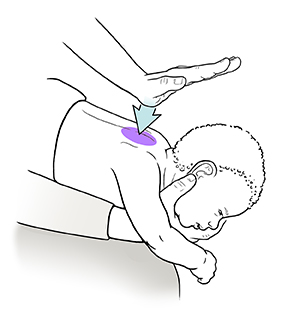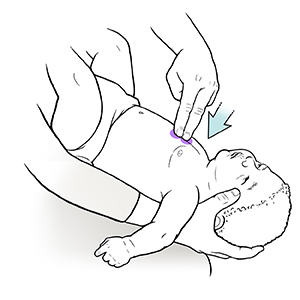A
B
C
D
E
F
G
H
I
J
K
L
M
N
O
P
Q
R
S
T
U
V
W
X
Y
Z
Click a letter to see a list of conditions beginning with that letter.
Click 'Topic Index' to return to the index for the current topic.
Click 'Library Index' to return to the listing of all topics.
When a Baby Is Choking (Up to Age 1)
Babies often want to put things into their mouth. This includes toys and food. It can also include anything they find nearby, such as a pen cap or coin. Small objects can choke a baby. This happens when the object slips into the baby’s airway (trachea).
Choking may result from a complete or partial blockage of the airway:
A blocked airway can be very serious, even deadly. Choking can block the flow of air and cut off oxygen to the brain.
This sheet can help you prepare for a choking emergency. It will also help you take steps to prevent a baby from choking.
What are choking hazards?
Any object small enough to enter a baby's airway can block it. This includes:
-
Small food pieces, such as nuts, grapes, beans, popcorn, hotdog pieces, or food that hasn’t been chewed well.
-
Small household objects, such as buttons, marbles, coins, balloons, or beads.
-
Small toy parts.
-
Breast milk or formula swallowed too quickly.
-
Too much mucus in the throat.
Signs of choking
The signs of choking can include:
-
Weak or no cough.
-
A high-pitched sound when breathing in.
-
Being unable to cough, breathe, cry, or make sounds.
-
Face that turns pale and blue-tinted.
-
Panicked, confused or surprised appearance.
Assessing the situation
DO NOT perform the following steps if the infant is coughing forcefully or has a strong cry, either of which can dislodge the object on its own.
The steps to take when a baby is choking will vary in these situations:
-
If a baby has trouble breathing and can’t cry or make sounds and is conscious.
-
If a baby faints, stops breathing, or is unconscious.
If a baby has trouble breathing and can’t cry or make sounds and is conscious:
-
Don't put your finger into the baby’s mouth to remove the object. Your finger could push the object deeper into the baby’s throat.
-
Tell someone nearby to call 911.
-
Perform the choking rescue maneuver. (See "How to help a choking baby" below).
If a baby faints, stops breathing or is unconscious:
-
Tell someone nearby to call 911. If you are alone, use a cell phone to call 911. Put it on speaker mode while you begin CPR.
-
Lay the baby down on their back on a hard, flat surface, such as a table, floor, or the ground.
-
Start cardiopulmonary resuscitation (CPR). If you do rescue breaths, look for an object in the mouth or throat each time the airway is opened during CPR. If you see the object, take it out. But if you can't see the object, don't stick your finger down the baby's throat to feel for it.
-
Repeat CPR until emergency services arrive, or until the baby starts breathing.
How to help a choking baby


-
Lay the baby stomach-down on your forearm. Gently support the baby’s face and neck in your hand. Make sure that the baby's head, neck, and back are supported. If needed, sit down and rest your arm on your thigh. Make sure the baby’s head is slightly lower than the rest of their body. This will help the object to be dislodged from the throat more easily.
-
Use the heel of your free hand to give 5 quick thumps (back blows), using the palm of your free hand, between the baby’s shoulder blades.
-
If the object is still stuck in the throat, turn the baby face-up on your forearm. Support the head. Place 2 or 3 fingers in the middle of the baby’s breastbone just below the nipple. Push down about 1/2 to 1 inch. Do this 5 times fast.
-
Check the baby’s mouth to see if the object is dislodged. If not, repeat steps 2 and 3 until the baby’s throat is clear and the baby is breathing normally.
Help prevent a baby from choking
-
Keep an eye on babies as they eat or play.
-
Keep problem foods and objects away from babies. This includes small foods and small household objects.
-
Don’t let babies play with toys with small parts.
-
Childproof your home for safety by removing small objects that a baby might be able to reach.
-
Check for toys recalled for choking hazards on the Consumer Product Safety Commission website at www.cpsc.gov.
Online Medical Reviewer:
Chelsey Schilling BSN RN
Online Medical Reviewer:
L Renee Watson MSN RN
Online Medical Reviewer:
Lalitha Kadali
Date Last Reviewed:
5/1/2025
© 2000-2025 The StayWell Company, LLC. All rights reserved. This information is not intended as a substitute for professional medical care. Always follow your healthcare professional's instructions.